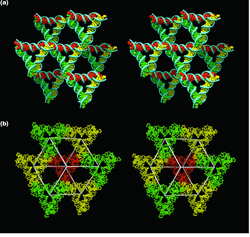Chemists from New York University prepared DNA structures. XNUMXD that is a breakthrough that is a bridge between the molecular world and the world we live in every day and between biotechnology and nanotechnology

Chemists from New York University prepared DNA structures. XNUMXD which is a breakthrough that forms a bridge between the molecular world and the world we live in every day. The research, published in the latest issue of the prestigious journal Nature, has a variety of possible industrial and medical applications, such as the preparation of nanoelectronic components and understanding the three-dimensional structures of drug receptors in the body.
While scientists, including those who conducted the above research, have already designed and prepared crystalline structures in the past, these structures were only two-dimensional (spread out on a single plane) and did not constitute the most faithful representation of "real" crystals.
In order to overcome this limitation, the research team, led by chemistry professor Nadrian Seeman, tried to design and prepare DNA crystals. Three-dimensional - a process that requires multiple spatial control over the three-dimensional structure of the material.
To achieve this goal, the researchers prepared DNA crystals. through the use of their synthetic sequences capable of self-organizing into a series of three-dimensional triangular structures. The preparation of the crystals was based on the addition of "sticky ends" - small "sticky" sequences at each end of the structure - which were connected to other beads while placing them in an orderly and directed array. The composition and nature of these sticky edges allow the structural units to join one another in a controlled and pre-planned manner.
The lead researcher and his colleagues had previously prepared crystals using this process; However, since these crystals arranged independently on the same plane, they were essentially two-dimensional in their final form. In the new study, the scientists expanded the canvas based on their previous experiments while taking advantage of the double-helix structure of DNA. in order to form three-dimensional crystals. The two-dimensional crystals are extremely tiny - about a thousandth of a millimeter - while the three-dimensional crystals are much larger and reach up to one millimeter and are even visible to the naked eye.
DNA coils Duplexes (double-stranded) are formed when single strands of DNA - each containing four molecular components called bases, linked by a common skeleton - are independently organized by a characteristic and unique connection between the bases. To these double helices, the researchers added sticky ends, i.e. chemically active ones, to obtain a sort of active single-stranded sliders at each of the ends of the double helices. When these sticky ends matched each other they joined together and thus connected two units of a double helix. This is actually a common method used by genetic engineers who apply it on a wider scale. By linking together several double helices through their sticky ends, the researchers were able to create a lattice-like structure that faces six different directions while obtaining a three-dimensional crystal array.
"With the help of this method we are able to organize much more material and orient it in a greater number of ways than with the two-dimensional crystals," explains the lead researcher.
A promising blueprint for implementing this approach lies in nanoelectronics, using components no larger than a single particle. Today, such products are built from two-dimensional components. Given the increased flexibility that these XNUMXD components can provide, manufacturers will be able to build smaller and more compact parts, as well as more sophisticated in their design.
The researchers also anticipate that they will be able to design biological macromolecules by attaching them to these crystals. This result could help a lot in drug development, because it will be possible to observe the macromolecules attached to these crystals by a measurement method known as X-ray crystallography. By adding drugs to the crystal arrays, it will be possible to observe, measure and understand the interrelationships between these biological components, such as the activity between an antibody and an antigen.
Biophysics researcher Bob Sweet, who performed X-ray crystallography measurements on the crystals notes that: "This is one of the neatest structures I've seen in years. He really connects biotechnology and nanotechnology."

3 תגובות
What is meant by "such as the preparation of nanoelectronic components and understanding the three-dimensional structures of drug receptors in the body."?
Does a structure under my dimensions prepare these structures or explain how they are built?
Moshe, I read your articles here and get the impression that you write them only for graduates in the field, because you use terms and do not explain them, such as: synthetic sequences, small "sticky" sequences at each end of the structure, and this entire paragraph:
"The researchers also anticipate that they will be able to design biological macromolecules by attaching them to these crystals. This result could help a lot in the development of drugs, because it will be possible to observe the macromolecules attached to these crystals by a measurement method known as X-ray crystallography. By adding drugs to the arrays of the crystals, it will be possible to observe, measure and understand the interrelationships between components These are biological, such as the activity between an antibody and an antigen."
Maybe a triangular pyramid? Built of triangular pyramids?
And maybe I'll get drunk I guess. Oops I have for three.
To the point, sounds interesting but too complex for a layman like me :}
Sorry,
What is a "three-dimensional triangle"?